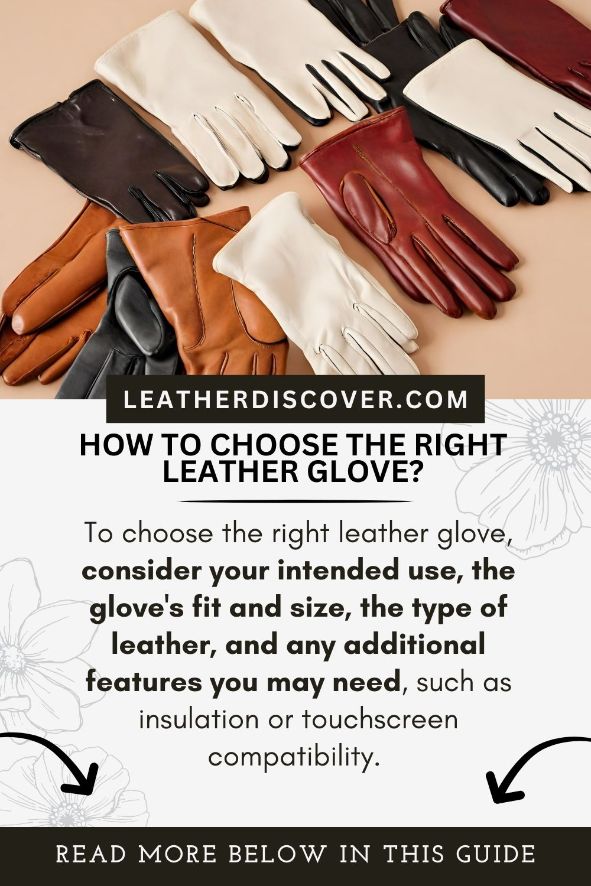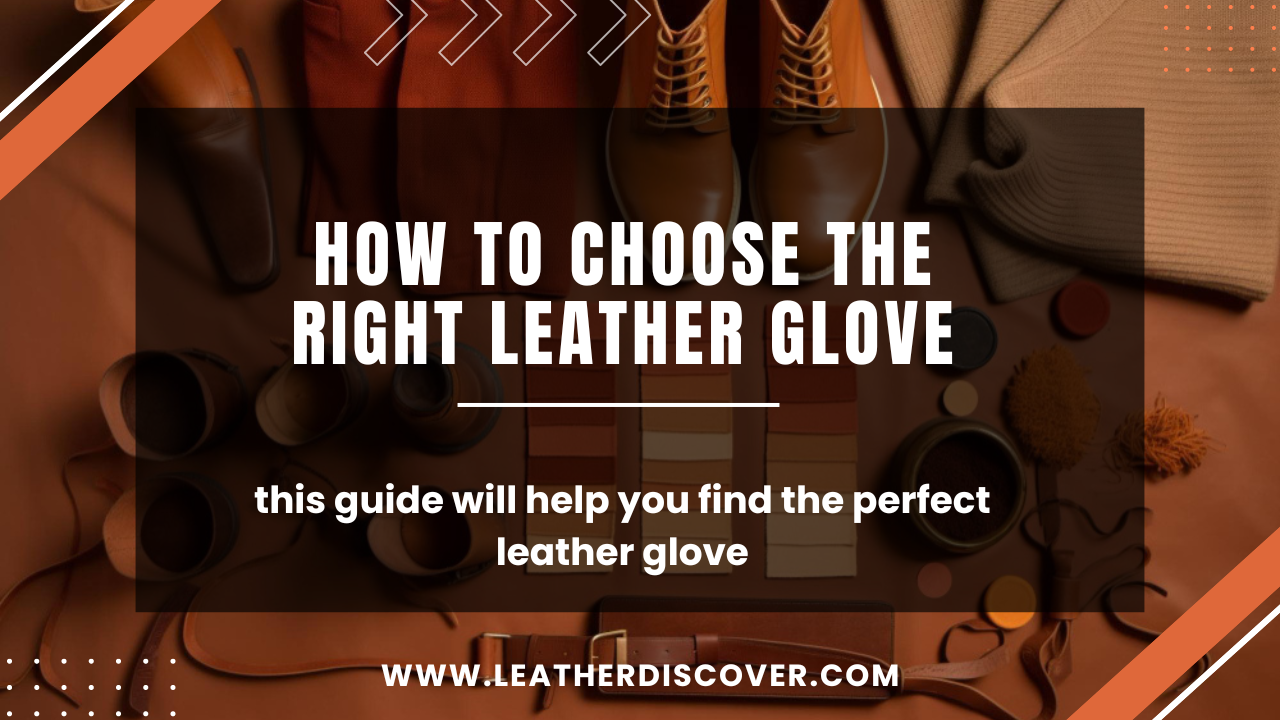Imagine you’re choosing a new superhero outfit, but it’s not a cape – it’s a leather glove! These gloves can be your trusty sidekick, keeping you stylish and helping you tackle tasks.
But how do you pick the right one? It’s like solving a puzzle. You need to think about why you want the glove, how it fits, and what it looks like.
This guide will help you find the perfect leather glove that matches your style and purpose.
In this article, we will explore: How to choose the right leather glove, choose the right size of leather gloves, how often to clean them, and more!
[toc]

How to Choose the Right Leather Glove?
Choosing the perfect leather glove involves considering a few key factors. Here are some considerations to make while making the decision of how to choose the right leather gloves:
1. Purpose:
While choosing the right leather glove, think about why you need the glove. Is it for fashion, driving, work, or a specific activity like biking or gardening? Different purposes require different features.
2. Leather Type:
There are various types of leather, like cowhide, goatskin, sheepskin, and more. Each has its own feel, durability, and appearance. Choose based on what you like and what fits your intended use.
3. Fit and Size:
The glove should fit snugly but not too tight. Measure your hand’s circumference and length, then consult the sizing chart provided by the brand to find the right size.
4. Lining:
Gloves can be lined with different materials like silk, cashmere, or fleece. Choose a lining that suits the weather and your comfort preferences.
5. Style and Design:
Leather gloves come in various styles, from classic to modern. Consider your personal style and what matches your wardrobe.
6. Stitching and Details:
Another very important thing to look for while choosing the right leather glove is to pay attention to stitching and other details. Neat stitching indicates quality. Look for extras like touchscreen compatibility or adjustable closures.
7. Color:
Leather gloves come in a range of colors. Consider what matches your outfits and personal preferences.
8. Durability:
Depending on how often you’ll wear them, consider the durability of the leather. Some types are more rugged and meant for heavy use, while others are more delicate.
9. Brand and Reviews:
Research brands with good reputations for leather gloves. Reading reviews can give you insight into the gloves’ quality and comfort.
10. Try Them On:
If possible, try the gloves on before purchasing. This helps you feel the fit and texture firsthand.
Should Leather Gloves Be Tight or Loose?
Leather gloves should have a snug fit, meaning they should closely follow the contours of your hand without feeling overly tight or restrictive.
A proper fit ensures that your gloves provide maximum dexterity and comfort. When you put them on, they may feel slightly snug, especially if they’re new, but leather has a tendency to stretch and mold to your hand’s shape with wear, becoming more comfortable over time.
If your leather gloves are too tight, they can be uncomfortable and restrict your hand movements.
On the other hand, if they are too loose, they won’t provide the necessary grip and control. It’s essential to find the right balance to maintain flexibility while ensuring a secure fit.
What Thickness of Leather for Gloves?
The ideal thickness of leather for gloves depends on their intended use and the level of protection required:
1. Thin Leather (0.5mm – 1mm):**
Thin leather gloves offer flexibility and tactile sensitivity. They’re suitable for tasks that demand precise movements, such as driving gloves or fashion gloves. However, they might not provide heavy-duty protection.
2. Medium Thickness (1mm – 1.2mm):
Gloves with medium-thickness leather strike a balance between dexterity and protection. They can be used for activities like cycling, light outdoor work, and casual wear.
3. Thicker Leather (1.2mm and above):
Thicker leather gloves offer enhanced durability and protection. They’re suitable for heavy-duty tasks like construction, gardening, or motorcycle riding, where there’s a higher risk of abrasion or impact.
Best Goatskin Work Gloves:
Goatskin work gloves are known for their durability, flexibility, and comfort. Here are a few highly-regarded options:
1. Ironclad Ranchworx:
Ironclad Ranchworx gloves are designed for heavy-duty work. They offer great protection and dexterity, making them ideal for construction and other demanding tasks.
2. Mechanix Wear M-Pact Leather:
Mechanix Wear M-Pact Leather gloves combine goatskin leather with impact protection features. They’re popular for tasks that involve both handwork and potential impact hazards.
3. Carhartt Insulated Grain Leather Work Glove:
Carhartt Insulated Grain Leather Work gloves feature goatskin leather and thermal insulation, making them suitable for cold weather work.
4. Youngstown Glove 03-3060-78-L Carpenter Plus:
Youngstown Glove 03-3060-78-L Carpenter Plus gloves are crafted for carpentry work. They offer a balance of durability, comfort, and functionality.
Deerskin vs Elkskin Gloves:
Here’s a comparison table between deerskin and elkskin gloves:
| Property | Deerskin Gloves | Elkskin Gloves |
|---|---|---|
| Material | Made from deer hide | Made from elk hide |
| Softness | Very soft and supple | Extremely soft and supple |
| Durability | Moderately durable | Highly durable |
| Warmth | Good insulation | Excellent insulation |
| Thickness | Thin to medium | Medium to thick |
| Comfort | Comfortable and conforming | Comfortable and conforming |
| Dexterity | Offers good dexterity | Offers good dexterity |
| Grip | Provides a good grip | Provides a good grip |
| Water Resistance | Resistant to light rain | Resistant to light rain |
| Puncture Resistance | Moderate resistance | High resistance |
| Use in Cold Weather | Suitable for cool weather | Excellent for cold weather |
| Use in Warm Weather | Suitable for warm weather | Suitable for warm weather |
| Typical Uses | Everyday wear, driving | Outdoor activities, hunting, work |
| Price Range | Moderate | Higher |
Why Is Glove Size Important?
Choosing the right glove size is crucial for comfort, protection, and performance. Here’s why glove size matters:
1. Comfort:
Gloves that are too tight can cause discomfort, restrict movement, and even lead to blisters or sores. Gloves that are too loose might not provide proper grip or control.
2. Dexterity:
Properly fitting gloves allow for better dexterity and tactile sensitivity. This is crucial for tasks that require precision and control.
3. Protection:
Well-fitted gloves offer optimal protection. Gloves that are too loose can leave gaps where hazards can enter, while too-tight gloves might tear under pressure.
4. Durability:
Gloves that fit well are less likely to wear out quickly. Proper sizing reduces strain on the seams and materials.
5. Safety:
For certain tasks, like using power tools or handling chemicals, loose-fitting gloves can be dangerous. Proper fit ensures that gloves stay in place during hazardous situations.
How Often Should I Clean and Condition My Leather Work Gloves?
The frequency of cleaning and conditioning depends on factors like how often you wear the gloves and the type of work you do. As a general guideline:
- Regular Use: If you wear your leather work gloves regularly, aim to clean and condition them every 2-4 weeks.
- Heavy Use: For gloves exposed to dirt, sweat, or harsh conditions, consider cleaning and conditioning them more often, perhaps every 1-2 weeks.
- Light Use: If you use the gloves occasionally or for less demanding tasks, you might need to clean and condition them less frequently, around once a month.
How Do I Know When It’s Time to Replace My Leather Work Gloves?
Knowing when to replace your leather work gloves is essential for maintaining safety and performance:
1. Visible Wear and Tear:
If you notice holes, rips, or visible damage that compromises the glove’s integrity, it’s time for a replacement.
2. Loss of Flexibility:
Leather work gloves should remain supple and flexible. If they become stiff and inflexible, they might not provide proper protection or comfort.
3. Exposed Seams:
If the seams are fraying or coming apart, the gloves won’t offer the same level of protection and durability.
4. Visible Dirt Buildup:
If cleaning and conditioning no longer restore the glove’s appearance or smell, it might be time to replace them.
Conclusion:
So, now you know how to choose the right leather glove and the factors to look for while choosing the right leather glove.
Choosing the right leather glove involves a combination of factors that ensure both comfort and functionality.
Prioritizing the right size is crucial for achieving a snug fit that enhances dexterity and warmth while wearing the gloves. Regular maintenance through proper cleaning is essential not only for preserving the leather’s quality and appearance but also for maintaining hygiene and extending the glove’s lifespan.
By considering these aspects—choosing the right type and size of leather gloves and adhering to a consistent cleaning routine—one can enjoy the utmost comfort, style, and durability that well-crafted leather gloves have to offer.
- What Is Caiman Leather? A Detailed Guide - July 25, 2024
- What Is Tumbled Leather?A Complete Guide - July 25, 2024
- What Is Kip Leather? Premium Leather Choice - July 24, 2024

